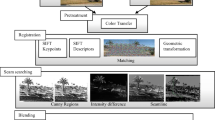Abstract
Existing mosaic construction algorithms have the following restrictions: (1) the scene is planar or very distant, or (2) the scene is generic but the camera motion is a pure rotation. In either case the registration of images could be captured by a global mapping named planar homography. In this work we address the general case: a generic scene pictured under an arbitrary camera motion. The image data so captured contains parallax that makes the registration of images a difficult problem. We introduce a framework that is capable of constructing mosaic from an image stream of even such a nature. The framework is devised on the basis of an algorithm we refer to as the three- image algorithm that, by the use of a third image, overcomes the parallax problem in registering images. We answer two questions: (1) how an image stream is divided into various 3-image sets for the three-image algorithm to iterate upon; and (2) how intermediate mosaic results over the various 3-image sets are accumulated to compose the overall mosaic at the end. The framework allows uneven sampling, in terms of space or time, of the video stream. Experimental results on real image data are presented to illustrate the performance of the proposed solution.
Access this chapter
Tax calculation will be finalised at checkout
Purchases are for personal use only
Preview
Unable to display preview. Download preview PDF.
Similar content being viewed by others
References
Dornaika, F., Chung, R.: Image Mosaicing under Arbitrary Camera Motion. In: Proc. of the 4th Asian Conference on Computer Vision, January 2000, pp. 484–489 (2000)
Faugeras, O.: Three-Dimensional Computer Vision: a Geometric Viewpoint. The MIT press, Cambridge (1993)
Hartley, R.I.: Projective Reconstruction and Invariants from Multiple Images. IEEE Transactions on Pattern Analysis and Machine Intelligence 16(10), 1036–1041 (1994)
Kumar, R., Ananadon, P., Hanna, K.: Direct recovery of shape from multiple views: a parallax based approach. In: IEEE International Conference on Pattern Recognition (1994)
Morimoto, C., Chellappa, R.: Fast 3D Stabilization and Mosaic Construction. In: Proc. of IEEE International Conference on Computer Vision and Pattern Recognition, June 1997, pp. 660–665 (1997)
Rousso, B., Peleg, S., Finci, I., Rav-Acha, A.: Universal Mosaicing using Pipe Projection. In: Proc. of IEEE International Conference on Computer Vision, January 1998, pp. 945–952 (1998)
Sawhney, H.S., Ayer, S., Gorkani, M.: Model-based 2D&3D Dominant Motion Estimation for Mosaicing and Video Representation. In: Proc. of IEEE International Conference on Computer Vision, pp. 583–590 (1995)
Sawhney, H.S., Hsu, S., Kumar, R.: Robust Video Mosaicing through Topology Inference and Local and Global Alignment. In: Proc. of Fifth European Conference on Computer Vision, June 1998, pp. 103–119 (1998)
Shashua, A.: Algebraic functions for recognition. IEEE Trans. On Pattern Analysis and Machine Intelligence 17(10), 779–789 (1995)
Shum, H., Szeliski, R.: Systems and Experiment Paper: Construction of Panoramic Image Mosaics with Global and Local Alignment. International Journal of Computer Vision 36(2), 101–130 (2000)
Zhang, Z.: Determining the epipolar geometry and its uncertainly: A review. International Journal of Computer Vision 27(2), 43–76 (1998)
Zhang, Z., Deriche, R., Faugeras, O., Luong, Q.-T.: A robust technique for matching two uncalibrated images through the recovery of the unknown epipolar geometry. Artificial Intelligence Journal 78, 87–119 (1995)
Author information
Authors and Affiliations
Editor information
Editors and Affiliations
Rights and permissions
Copyright information
© 2003 Springer-Verlag Berlin Heidelberg
About this paper
Cite this paper
Cheung, MT., Chung, R. (2003). Video Mosaicking for Arbitrary Scene Imaged under Arbitrary Camera Motion. In: Petkov, N., Westenberg, M.A. (eds) Computer Analysis of Images and Patterns. CAIP 2003. Lecture Notes in Computer Science, vol 2756. Springer, Berlin, Heidelberg. https://doi.org/10.1007/978-3-540-45179-2_32
Download citation
DOI: https://doi.org/10.1007/978-3-540-45179-2_32
Publisher Name: Springer, Berlin, Heidelberg
Print ISBN: 978-3-540-40730-0
Online ISBN: 978-3-540-45179-2
eBook Packages: Springer Book Archive




